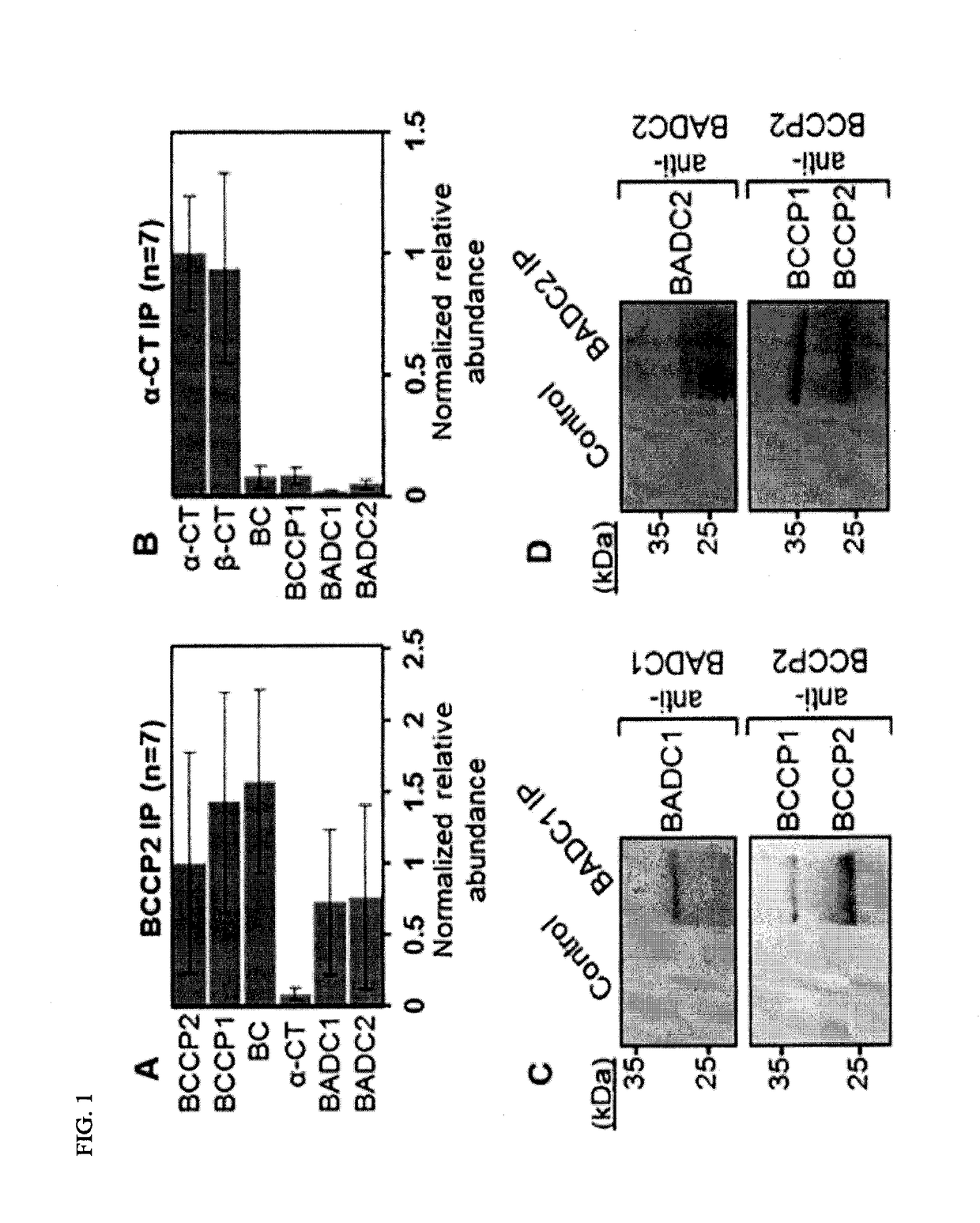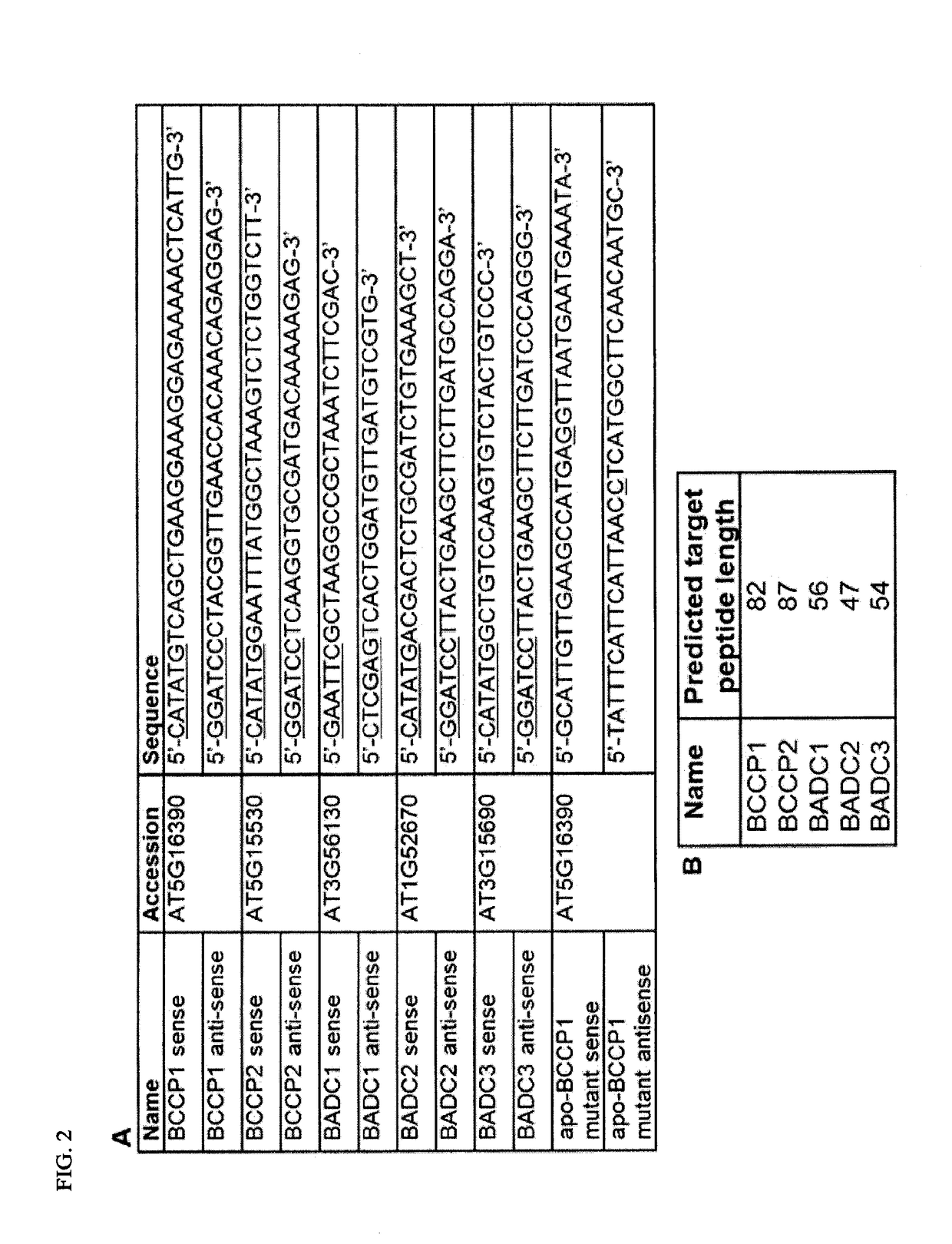Increasing plant oil content by altering a negative regulator of acetyl-coa carboxylase
- Summary
- Abstract
- Description
- Claims
- Application Information
AI Technical Summary
Benefits of technology
Problems solved by technology
Method used
Image
Examples
example 1
[0154]Two Novel Proteins, BADC1 and BADC2, Co-Immunoprecipitate with Hetaccase
[0155]To discover unknown protein interactors with the hetACCase, quantitative co-innmunoprecipitation (co-IP) analyses were performed. Wild type A. thaliana (ecotype-Columbia-0) were grown in a growth chamber with long-day (16 h, 23° C., 50% humidity, 50 pmol m−2 s−1) and short-night (8 h, 20° C., 50% humidity) conditions. For co-immunoprecipitation studies, 8.5 cm×8.5 cm pots were filled with moist soil (Sunshine Mix #6, Sun Gro Horticulture), covered with screen (1 mm2 pore size), and coated with seeds.
[0156]For co-innmunoprecipitation of hetACCase from Arabidopsis seedlings, crude chloroplasts were isolated from approximately 10 g 14-d-old A. thaliana seedlings after 1 h light exposure. Fresh leaves were homogenized in ice-cold grinding buffer (50 mM HEPES-KOH pH 8.0, 330 mM sorbitol, 1.5 mM MnCl2, 2 mM MgCl2, 2 mM EDTA, 0.1% (w / v) BSA) using a Waring blender. Homogenate was filtered through two layers...
example 2
[0162]Recombinant Protein Expression and Purification and Immunoblotting
[0163]The ORFs of BCCP1, BCCP2, BADC1, BADC2, and BADC3 were amplified via PCR from a cDNA clone (ABRC). The primer pairs for these amplifications were the same as those used in the yeast two-hybrid construct formation (FIG. 2). These primers were designed to remove the transit peptide, as predicted by TargetP. The amplified ORF of all five genes were cloned into either the expression vector pET28a or pET11a producing an N-terminal His-tagged fusion protein or an untagged recombinant protein, respectively. All constructs were sequence confirmed via DNA sequencing. Constructs were then transformed into E. coli strain BL21 (B2685: Sigma). Recombinant protein was expressed and purified from transformed BL21 cells as described in Swatek et al., J Proteome Res 10(9):4076-4087, 2011). For co-expression studies, ˜200 ng of each plasmid was used to transform BL21 cells.
[0164]Proteins resolved by SDS-PAGE were transferre...
example 3
[0165]Orthogonal Approaches Confirm a Direct Interaction Between Three BADC and Two BCCP Isoforms from Arabidopsis.
[0166]Yeast two-hybrid construct design. The ORF of genes of interest were inserted into bait and prey vectors PGBKT7 and pGADT7. Primers were designed to exclude the transit peptide from the coding region, as predicted by TargetP (FIG. 2). Genes were amplified from cDNA clones obtained from the Arabidopsis Biological Resource Center Amplicons were first inserted into Zero Blunt TOPO vector (Life Technologies) and checked for errors by DNA sequencing. Error-free amplicons were then subcloned into either pGBKT7 or pGADT7 vector. Completed constructs were transformed into competent DH5α cells. Cells transformed with pGBKT7 and pGADT7 were grown on LB media agar plates containing 50 pg / mL kanamycin (Kan) and 100 pg / mL ampicillin (Amp), respectively. Plasmids were purified from 5 mL culture of positive colonies using Q1Aprep Spin Miniprep kit (Qiagen).
[0167]To confirm the ...
PUM
| Property | Measurement | Unit |
|---|---|---|
| Fraction | aaaaa | aaaaa |
| Fraction | aaaaa | aaaaa |
| Fraction | aaaaa | aaaaa |
Abstract
Description
Claims
Application Information
 Login to View More
Login to View More - Generate Ideas
- Intellectual Property
- Life Sciences
- Materials
- Tech Scout
- Unparalleled Data Quality
- Higher Quality Content
- 60% Fewer Hallucinations
Browse by: Latest US Patents, China's latest patents, Technical Efficacy Thesaurus, Application Domain, Technology Topic, Popular Technical Reports.
© 2025 PatSnap. All rights reserved.Legal|Privacy policy|Modern Slavery Act Transparency Statement|Sitemap|About US| Contact US: help@patsnap.com



